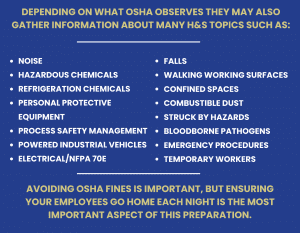There are many food manufacturers and employees in Ohio. Unfortunately, food manufacturing historically has had greater injury rates when compared to all manufacturing. Some of the most concerning injuries are amputations, cuts, lacerations, punctures, and both heat and chemical burns. OSHA has determined that there are deficiencies in machine guarding and ineffective energy control procedures (lockout/tagout) in many food processing facilities. As a result, OSHA has established a local emphasis program (LEP) for food manufacturers in Illinois and Ohio for 2023. The objective of the LEP is to encourage employers to identify and reduce or eliminate machine hazards during production and sanitation as well as during service and maintenance.
The manufacturers that are covered is quite broad, including sugar and confectionery products, fruit and vegetable specialty foods, dairy products, animal processing, nuts and peanut butter manufacturing, snacks, coffee and tea, flavorings, dressings, spices and perishable prepared foods, to name a few.
 I’m sure you are curious about what this means for food manufacturing! OSHA will continue to respond to employee complaints and referrals and will also use a randomized list of food manufacturers to schedule inspections. The scope of the inspections will initially be machine guarding, lockout/tagout and chemical and physical burns.
I’m sure you are curious about what this means for food manufacturing! OSHA will continue to respond to employee complaints and referrals and will also use a randomized list of food manufacturers to schedule inspections. The scope of the inspections will initially be machine guarding, lockout/tagout and chemical and physical burns.
For you to be prepared:
- Make sure your OSHA 300 Log is current and readily available. OSHA will be looking for injuries associated with machine guarding or lockout/tagout deficiencies.
- Have your written energy control program available, including equipment specific procedures. Check that all the documents are current.
- Have your authorized and affected employee lockout/tagout training records available. Be sure your training is current and don’t overlook your sanitation crews.
- Have your annual periodic inspection of control procedures records available.
After the records review, OSHA will walk through the facility looking for adequate machine guarding and opportunities to come into contact with hot or cold surfaces and corrosive chemicals. It’s likely OSHA will schedule to come back on another shift when sanitation occurs and will want to talk to other contractors on-site.
If you have questions about any of the above topics, Safex can answer your questions at info@safex.us or we have upcoming webinars that may provide more information. Safex Webinar Schedule
